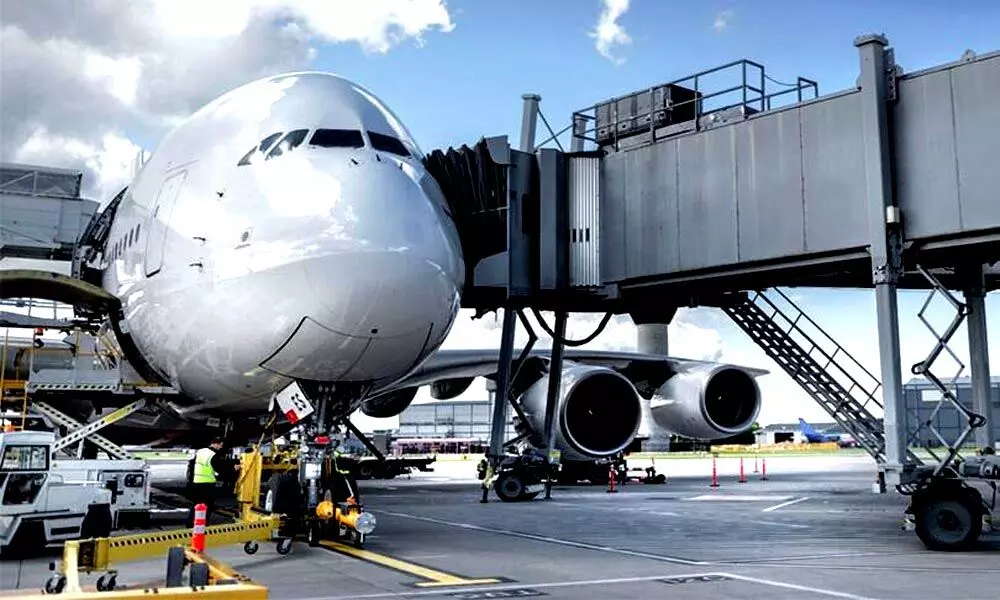Indian aviation industry on high-growth trajectory
In 2010, 79 million people travelled to/from/or within India. It doubled to 158 mn in 2017, and is expected to treble to 520 mn by 2037
image for illustrative purpose

With the prospect of over-capacity for several years to come, the Indian airports will need to shift to airline-driven and passenger-centric business models in which they will have to fight to attract traffic and generate revenue
A rising proportion of middle-income households, healthy competition amongst low-cost carriers, infrastructure build-up at leading airports and supportive policy framework will see India become the third largest aviation market in the world by 2024
In 2010, 79 million people travelled to/from/or within India. By 2017 that doubled to 158 million, and this number is expected to treble to 520 million by 2037. With the air passenger traffic projected to increase, the Indian aviation industry is on a high-growth path.
To satisfy the current and projected rise in demand for commercial air travel, Indian airlines have placed large orders for aircraft. The nation's airplane fleet is projected to quadruple in size to approximately 2500 airplanes by 2038.
Currently, the country has 128 operational airports including 29 international, 89 domestic, and 10 custom airports. To meet the growing demand for air travel in India, it has become imperative to increase the capacity of airport infrastructure.
To augment the airport infrastructure the government aims to develop 100 airports by 2024 (under the UDAN Scheme) and expects to invest $1.83 billion in the development of airport infrastructure by 2026.
The projected upsurge in air travel in India would require more aircraft usage, thus, in turn, igniting the demand for Maintenance, Repair and Overhaul (MRO) services. The Indian Civil Aviation MRO market, at present, stands at around $900 million and is anticipated to grow to $4.33 billion by 2025 increasing at a CAGR of about 14-15 per cent.
The government has plans to privatise 25 more airports in India over the next five years. The plan, categorized under National Monetization Pipeline (NMP), was revealed by the Minister of State in the Ministry of Civil Aviation General (Dr) V K Singh Retd in a written reply to a question in Lok Sabha.
The airports at Bhubaneshwar, Varanasi, Amritsar, Trichy, Indore, Raipur, Calicut, Coimbatore, Nagpur, Patna, Madurai, Surat, Ranchi, Jodhpur, Chennai, Vijayawada, Vadodara, Bhopal, Tirupati, Hubli, Imphal, Agartala, Udaipur, Dehradun and Rajahmundry are the ones earmarked for asset monetization over the years 2022 to 2025.
The 25 airports are identified based on criteria such as annual traffic above the threshold of 0.4 million passengers and airports with an ongoing capital expenditure plan according to the National Infrastructure Pipeline (NIP). In August, the government had said that it was planning to raise Rs 20,782 crore within four years for the purpose.
The Airports Authority of India (AAI) has identified Tiruchirappalli (Trichy) International Airport in Tamil Nadu among 13 airports for operations, management and development of the airports through the Public-Private Partnership (PPP) model in the public interest and for better control of the airports.
Revenue has plummeted, but airport operators are faced with fixed costs that represent an even higher share of their total costs than is the case for airlines. And they have massive capex commitments.
The decimation of international traffic has been particularly painful for airports. Aero and non-aero revenue are both critically dependent upon international operations. In FY2021, India's airport operators lost $942 million, while other on-airport concessionaires (e.g. for ground handling, duty free, retail, food and beverage, car parking etc.) lost a further over $1 billion. Airport-based businesses, therefore, lost $2.0-2.5 billion in total.
The recovery in international traffic continues to be constrained by a combination of muted demand as well as supply side issues. India has suspended bilateral air service agreements (BASAs) with more than 100 countries, and instead replaced them with air bubble agreements with revised capacity and conditions. To date, such agreements have been signed with only 28 countries. This new framework has impacted international capacity.
In light of these conditions, airport operators are facing severe financial stress which is reaching critical levels.
Indian airport operators are highly leveraged with limited scope to increase debt. Given the need to raise capital as a result of Covid (especially to finance non-aero losses and capex), financing will therefore need to come in the form of equity. If incumbent promoters are unable to infuse the necessary funding this may lead to changes in ownership and precipitate a second wave of consolidation in the airport sector. With the prospect of over-capacity for several years to come, the Indian airports will need to shift to airline-driven and passenger-centric business models in which they will have to fight to attract traffic and generate revenue.

